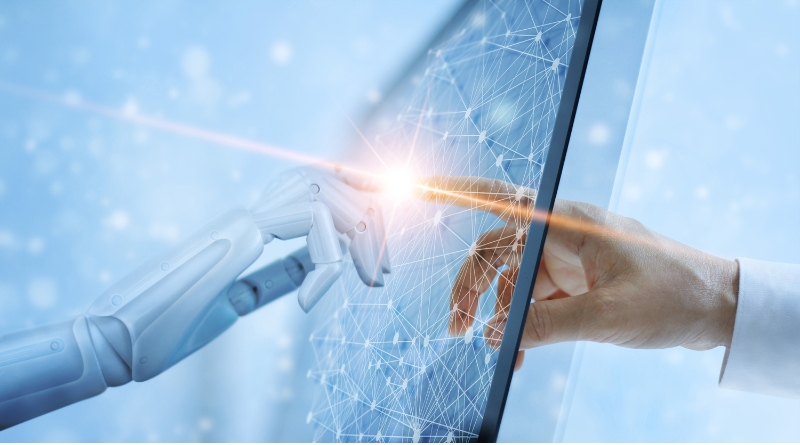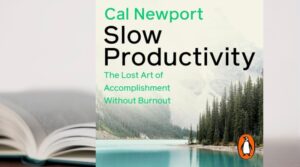
Part 1 Introduction – Technology’s Trojan Horse
‘We shape our tools and then our tools shape us’ (William J. Mitchell – 1992)
What is CyberPsychology?
Just before we begin, it is probably worth explaining what CyberPsychology is.
A reciprocal relationship
There is a two-directional aspect to the study of how, where and when technology and human behaviour interact.
The first aspect investigates the understanding of how our behaviour and psychology (in both the online and offline worlds) affects and determines how we use technology. For example, during Lockdowns younger people increased their use of social media and gaming as a way to connect with others and attempt to mitigate a loss of control during an othersiwe fearful time. Extroverts felt isolated while working from home, so spent more time online connecting with others.
The second aspect is the understanding of how our technology use, in turn, affects and changes our behaviour and psychology (in both the online and offline worlds). Amongst other examples, we know that social media use can impact our emotions, self-esteem and mental health – either positively or negatively.
This back-and -forth influence on our behaviour, psychology and technology use is constantly evolving. Unlike other psychology disciplines, a lot of what is currently being researched in CyberPsychology can be outdated within a few years. So, we are often kept on our toes to keep up with innovations and the psychological impact – positive or negative.

There are many examples of the reciprocal relationship of technology and human behaviour.
One example is a fitness tracker app on a smart watch. These apps can effectively be used to measure healthy fitness progress against base levels through monitoring levels of activity against goals and provide motivation for further improvement.
However, this same app can push some into harmfully addictive fitness regimes, where the obsession to improve training scores can become detrimental to the individuals health. This can be exacerbated when results are shared with others or made availabe online.
A new psychological discipline
Digital technology’s impact on human behaviour and psychology has only really been investigated since the more ubiquitous use of the personal computer in the early 1990’s – so is a fairly recent addition to the stable of psychology disciplines (if you consider 35-ish years of research and practice ‘new).
It was only launched as a section of the British Psychological Society in 2018 and has only slowly gained traction in the world outside of academics and cybersecurity since then.
The majority of CyberPsychologists focus on cybersecurity-based behaviour, the forensics of cyber-criminals, and online addictions such as gaming, sexting, pornography, gambling or technology use amongst children and teens.
Very little focus, amongst CyberPsychologists anyway, has been on digital technology use amongst adults and even less on how it is used in the context of work and work creep.
This project is an attempt at a starting point to address this low level of awareness amongst the general working population of the impact of workplace technology use outside of designated working hours.
To put our current situation in context, it is worth a brief glimpse backwards to view how recent historical technology inversions have changed us as individuals and as a society.
Lockstep socio-cultural norms and worldview biases shift
We make tools, and tools make us.
Although media and cultural narratives focus solely on how digital technology is changing our social and individual behaviour and psychology, history has an expanse of tools that have been invented to facilitate basic life functioning, making it simpler, more fun, more productive and more enjoyable. Each innovation has shifted our worldview, expectations and behaviour for millennia.
Because, in the process of using these tools, we changed not just the ease of the task for which it was invented, but also how we exist, how we do life, and our perspective of the world we occupy, our society and ourselves.
These innovations have unintended consequences, whether positive or negative, that outstrip the design or intention for which the tool was originally developed.
Basic farming tools allowed nomads to settle in one place and pour their energy into growing crops and raising herds rather than spending long hours foraging and hunting for their daily sustenance. No longer subject to seasonal migrations, settlers were able to spend substantially less energy on planting, nurturing and gathering fruit, grains and vegetables, and managing livestock. They had more energy and time to pour into the settling process which made them landowners and gave them a dominion to manage and rule. In doing so, they built dwellings, storage facilities and water solutions.
The printing press encouraged greater levels of literacy as printed material became more available (and affordable) for the common man. It changed how information was memorised, retrieved and used. Oral cultures that rely on communal memory and include the re-telling of stories and proverbs transmitted from one generation to the next to keep information, history and tradition alive, started to fade. Literary cultures that rely on individual understanding of where to find and retrieve information, as and when needed, started becoming the norm. It improved overall literacy levels, reducing dependence on group memory, and increasing income prospects for the common citizenry.
Mechanical farming equipment divided communities as rural employment decreased, forcing people to relocate to cities to find new forms of employment. Single-person accommodation was needed and people began to populate towns in search of work. Entertainment and subsistence catering to single people thrived. Simultaneously, the population and trading options in rural areas shifted with the departure of workers and their pay packets.
More recent household innovations such as the washing machine (originally called ‘The Liberator’) promised to reduce the time and effort women spent in the back-breaking and time-consuming grind of weekly laundry. Similar domestic labour and time-saving devices facilitated greater participation of women in the workplace, while still being able to juggle their home-based responsibilities. Dual-income households increased overall wealth per family unit, growing the demand and consumption of luxury goods and services, different housing options, more fast food and packaged meals in addition to a greater need for daytime childcare services. More women in the workplace gave rise to: more independence, a changed perspective of marriage, children and what it means to be a good mother in addition to what it means to be a productive, contributing women to society.
Compounded advances in digital technological innovations
Digital technological is no exception.
Just taking a look at the steady stream of communication, music and entertainment innovations over the past 100 years of so, we can get a glimpse into how we have changed.
Pre-1990
For the majority of the last century, the majority of our communication and entertainment was fixed to a location and was a shared experience. Making a call or playing music involved group consumption. We needed to be cognisant of all those within earshot – our immediate community – consciously aware of who was listening in to the conversation, or what music they preferred.
Post 1990 & Pre-Y2K
When this technology became untethered and mobile – near the end of the 20th Century – our enjoyment of music became one of individual consumption. We could curate our own playlists, without needing to consider the interests, needs or tastes of others nearby, and listened to them on our own.
Our conversations became more private, and we quickly switched from calling and writing to emailing and texting.
Post Y2K
At the turn of the Century, with the introduction of blackberry and then smartphones, we could send emails on the move and take our music library wherever we went.
The Cloud meant we had the internet in our pockets and the office at our fingertips.
Our music and engagement with others became semi-joint curated by AI. We created playlists and wish lists, but AI makes recommendations on what we watch, listen to and read.
We browse social media, thinking we have control, but AI algorithms curate our feed based on our previous likes, recommendations and post engagements. AI started deciding for us what social media posts we’re fed, what entertainment we’d prefer and what information to display in our search engines. Our feed and entertainment becomes an echo chamber of our own preferred biases. Which takes us to a place of less community-based, and a more internally focussed worldview and way of thinking.
We now spend less time engaging with human others, and curating our own preferences, and more time engaging with Alexa, Siri or ChatGBT.
AI, virtual reality, augmented reality and the metaverse are taking us to a whole different place altogether.
Our norms of communicating with others (both on and offline) and listening to our music will continue to shift as we take new technology on board.

Although there is an argument to say that the digital revolution has unrecognisably shifted so much of what we do, it is hard to measure whether the invention of digital technology has been either more or less impactful that any other historic innovation.
The difference is in the timescale of that shift.
Within a few decades, communication, music and entertainment tech has moved from a stationary, tethered, community-based, managed activity to a mobile, rechargeable, individualistic, more curated one.
In less than a generation, childhood shifted from ‘analogue’ to ‘digital’.
There are many a Generation X-er who lament the ‘innocent, carefree days’ of their childhood when compared to the digital childhood of their immediate offspring.
The conversation on this topic will often start with words such as, ‘When I was a child, we used to spend our afternoons and weekends …’ and continue with how their own children spend so much of their time stationary, bent over a screen, scrolling through feeds or playing online games … never really going outside, not having as many off-line friends, not learning as many social skills…
If you grew up before the introduction of the iPhone, you will have your own version of this same story about your analogue childhood days.
And this is where the difference in innovation lies.
Historically, innovations took longer than one generation for the impact to really be realised.
The exponential growth of digital technology innovation is compounding to the initial impact being witnessed as a lived experience.
Narrative: keep up … or get left behind
When it comes to workplace technology, it is often said that if you’re not keeping up, you very quickly get left behind.
Being good at your job is no longer about the technical knowledge and skill required to get your job done productively and competently.
If you are not digitally intelligent enough to keep up with your colleagues and others in your industry, you will quickly get left behind and be passed over by others who are.

The social and professional norms that accompany these innovations seem to be in constant flux.
Expectations around professional and work-based behaviour, and our transition into a hybrid working world, have brought us to the point where we feel we need to be ‘Always On, and Always Available’, or we risk being seen as ‘not an ideal worker’ at best, risk being glossed over for the promotion, or losing our job at worse.
So, spending time on work-based gadgets during our private time has become the expected norm.
And, it is often difficult to draw a personal strategic boundary between our career ambitions and what seems like a juggle with home and family life.
Many of us feel that we can never switch off – just in case we get left behind, get left out, miss something crucial, fall behind on that ever-increasing workload, not get that email or message in time, get passed over for someone else because they were in the office more often, got more involved in group chats, sent more emails on weekends and holidays, kept more balls juggling, engaged in more company social media activity…
Because being good at your job is no longer just about the technical knowledge and skill level needed to get the job done in a productive and competent way. If you do not have the same level of digital intelligence and ability as your colleagues and those in your industry, you will get left behind.
Taking stock: why is it important to understand the impact of digital technology?
Simply put: using digital technology has, and continues to, permanently shape and shift our culture, our worldview, expectations, biases, and individual psychology and well-being – both for the better and for the worse.
By understanding these shifts and implications, we can make informed decisions and choices about how we continue to use our technology and what we need to change – in how we work, live and play.
But, we don’t always get the chance to stop and think about how we got here, how technology is impacting us for the positive or negative, whether we ought to step off the merry-go-round, and what that looks like for each of us.
This is what this project is attempting to address – how the use of technology in the workplace is shaping and shifting us, the expectations and biases that we have around how we are expected to work, and the role technology plays in getting the job done.
Knowledge work and what it means
Although there are several different types of work that we do, as adults, that involve the use of technology to accomplish our paid work, we will be focussing specifically here on Knowledge Workers.
From a CyberPsychology perspective knowledge workers are employees who work to produce intellectual assets through the use of digital technology tools.
Cal Newport, in his book ‘Slow Productivity’, gives the term a more generic definition:
“The economic activity in which knowledge is transformed into an artefact with market value through the application of cognitive effort”.
Notes:
- The opening quote: ‘We shape our tools and then our tools shape us’ (William J. Mitchell – 1992), The original concept of this statement is attributed to Winston Churchill, and adapted by a few including, William J. Mitchell and Marshall McLuhan to its current form, both in an echo of a speech made by Winston Churchill speaking about the rebuilding of London after WWII, where he said, ‘we make buildings and buildings make us’. William J. Mitchell stated in 1992 that ‘tools are made to accomplish our purposes, and in this sense, they represent desires and intentions. We make our tools, and then our tools make us: by taking up particular tools we accede to desires, and we manifest intentions’. You can read more here.
- You can read more about the fable of the Trojan Horse here.










